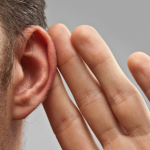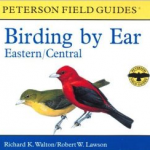Its springtime here in the northeast, and the migrants are coming through and filling the air with song, bringing us to today’s topic. When searching for birds, most beginning birders focus on the ‘watching’ part of birdwatching; looking for bright colors and trying to spot movements that reveal the presence of a bird. That is a very reasonable place to begin, but perhaps the main difference between novice and experienced birders is that skilled birders are much more attuned to finding birds by using their ears. We birders are fortunate that birds often make sounds that reveal their presence, unlike animals like deer, reptiles, butterflies, etc. that typically remain silent to avoid detection. This is incredibly valuable because even the most colorful birds can be very difficult to find when they are not moving. Bird sounds can range from full-scale songs intended to advertise territory or to attract a mate, to contact calls for communicating with their partners or other members of their flock, to warning calls signaling that danger is near, to begging calls from juveniles to their parents. Many of these sounds are distinct for a particular species and can even be used to distinguish species that are outwardly very similar.
the most colorful birds can be very difficult to find when they are not moving. Bird sounds can range from full-scale songs intended to advertise territory or to attract a mate, to contact calls for communicating with their partners or other members of their flock, to warning calls signaling that danger is near, to begging calls from juveniles to their parents. Many of these sounds are distinct for a particular species and can even be used to distinguish species that are outwardly very similar.
It is intuitive that using the two senses of sight and hearing to finds birds will result in greater success than using only one of them, but it is perhaps not so obvious that birding by ear often is actually more productive than using vision. This is due to the fact that we can hear all around us while our vision is restricted to just a portion of the view in front, so birding by ear enables detection of birds in all directions. Moreover, sounds travel around obstacles, so a bird that is obscured by a leaf or a branch might not be visible, but can still be heard. Thus, under the most difficult viewing conditions, such as when birds are singing from within thick foliage, or from the dense reeds of a marsh, or even at night when we can’t see them at all, they can still be identified if they are vocalizing. As a gauge of its importance, I estimate that when I am birding for spring migrants, perhaps 70% of the birds are located and identified first by sound, and only subsequently by sight. That means that if you are only birding by sight, then you are missing well more than half of the birds in the area.
Assuming that you now are convinced that birding by ear is a useful skill that can bring your birding to a new level, how then do we go about developing that skill? I pass along two suggestions that I found helpful. First of all, birding by ear is a skill that does not just happen because we want it to happen. It is something that we need to develop actively. Although it is theoretically possible to download recordings of bird songs and attempt to memorize them one by one, in practice this is not a realistic goal. Most of us simply do not have the ear to distinguish and memorize hundreds of songs without first learning HOW to do it. Fortunately, instructional series exist that teach the songs of many bird species, and it is well worth the investment to  acquire these lessons. I highly recommend the Peterson Field Guides Birding By Ear and More Birding By Ear discs. These lessons teach bird song brilliantly using a few simple techniques. First, the bird songs are placed into logical groups (Warblers with simple songs, Warblers with complex songs, Thrushes, Vireos, Woodpeckers, etc.) that typically consist of four to seven species, thereby simplifying the process. Thus, even if we can’t at first identify the species, at least we can narrow it down to a small group of possibilities. Second, within the groups, the songs are repeated and compared to each other, stimulating the learning process. Finally, the methods used in these lessons train us to listen to the structure of the song, its length, its volume, and its tone. The same methods can be used to analyze the songs of any new species that might be heard. For example, if I travel to a foreign country and hear a song for the first time, I immediately take note of whether the song consists of simple repeated notes or has a more complex structure, whether the song changes in volume or pitch, and whether it has multiple parts. Similar to the way we learn key identification points when birding visually, these lessons teach the audible clues that are diagnostic for common bird species.
acquire these lessons. I highly recommend the Peterson Field Guides Birding By Ear and More Birding By Ear discs. These lessons teach bird song brilliantly using a few simple techniques. First, the bird songs are placed into logical groups (Warblers with simple songs, Warblers with complex songs, Thrushes, Vireos, Woodpeckers, etc.) that typically consist of four to seven species, thereby simplifying the process. Thus, even if we can’t at first identify the species, at least we can narrow it down to a small group of possibilities. Second, within the groups, the songs are repeated and compared to each other, stimulating the learning process. Finally, the methods used in these lessons train us to listen to the structure of the song, its length, its volume, and its tone. The same methods can be used to analyze the songs of any new species that might be heard. For example, if I travel to a foreign country and hear a song for the first time, I immediately take note of whether the song consists of simple repeated notes or has a more complex structure, whether the song changes in volume or pitch, and whether it has multiple parts. Similar to the way we learn key identification points when birding visually, these lessons teach the audible clues that are diagnostic for common bird species.
Learning all the bird songs, however, is only part of the story. A second step is to develop techniques that make it possible to hear and register as many sounds as possible. Of utmost importance, birding ideally should be done quietly to enable hearing weak, high-pitched, or distant sounds. But even moreso, we need to train ourselves to immediately connect that sound with the correct species. I have found it an extremely helpful exercise to walk through the woods, consciously (and quietly) saying the name of each species that I hear. As this process is repeated, I find that it has enabled me to recognize more sounds or deeper layers of sounds than I had recognized previously. It is as if by the act of saying the birds name, your mind actively registers for example that there is a Cardinal on the left and an Ovenbird is ahead and a Black-throated Green Warbler is directly above, and then it starts listening for more. If you hear a sound and can’t say the name of the bird, then it is time to stop and figure it out before moving on, since you will likely meet that species again later in the day. This skill is probably analogous to listening to a complex piece of music, where a casual listener upon first exposure might hear only the most obvious parts of the piece, whereas a trained musician immediately hears the deeper layers created by the strings, horns, vocals, and percussion lines.
Now a few parting thoughts. Don’t expect birding by ear to be a simple process, but do expect it to be very rewarding as your skills improve. Consider it a long-term goal that you will not achieve in a single year. It is not necessary to know every song of every bird. Focus first on the sounds of your local resident species; anticipate what will be the most abundant 10 or 20 species in your area, learn their songs, and then you simply need to listen for new songs when birding, which will result in finding new birds. Don’t be surprised if you will need to refresh your memory of the songs and calls of migrants every year when they come through. Above all, hang in there and enjoy the process. Take joy and satisfaction from the new songs that you have learned rather than becoming frustrated because you don’t yet know them all. It will come with time. It is a great feeling to reach the stage where you can walk through the woods confidently knowing which birds are making those beautiful sounds without even raising your binoculars.
More advice can be found HERE in part 2 of this series, or go back to part 1.